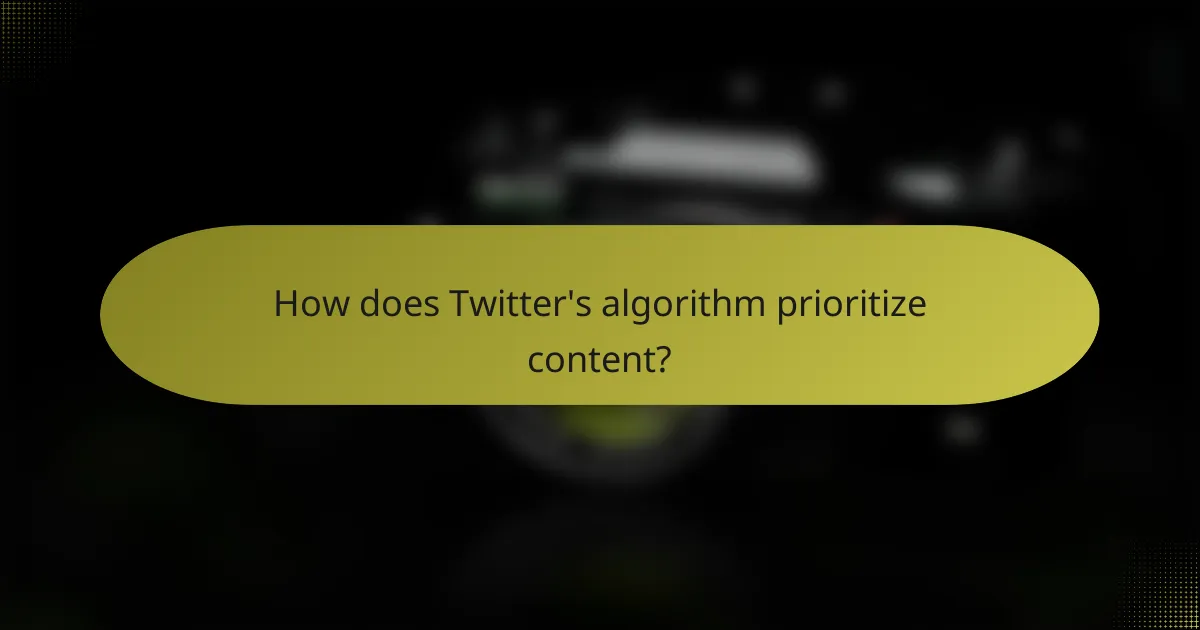User behavior plays a crucial role in shaping Twitter’s algorithm, influencing which tweets gain visibility in users’ feeds. By analyzing engagement levels and content preferences, brands can tailor their marketing strategies to enhance visibility and connect more effectively with their audience. Leveraging trending hashtags and engaging multimedia content can significantly boost marketing success on the platform.

How does user behavior influence Twitter’s algorithm in Australia?
User behavior significantly impacts Twitter’s algorithm in Australia by determining which tweets are prioritized in users’ feeds. Factors such as engagement levels, interactions, and content preferences shape the visibility of posts, directly affecting marketing success on the platform.
Engagement metrics drive algorithm decisions
Engagement metrics, including likes, retweets, and replies, play a crucial role in how Twitter’s algorithm ranks content. Higher engagement signals to the algorithm that a tweet is valuable, leading to increased visibility in users’ timelines. For marketers, focusing on creating engaging content can enhance interaction rates and improve overall reach.
In Australia, brands should consider timing their posts to align with peak user activity hours, which can vary across regions. Experimenting with different content types, such as images or polls, can also help boost engagement metrics.
Content relevance affects visibility
The relevance of content to a user’s interests and previous interactions greatly influences its visibility on Twitter. The algorithm analyzes user behavior to determine which topics are most appealing, ensuring that users see tweets that align with their preferences. Marketers should tailor their messaging to resonate with their target audience’s interests for better visibility.
In practice, utilizing hashtags relevant to Australian trends and topics can enhance the relevance of tweets. Regularly reviewing analytics to understand audience preferences can guide content creation, ensuring it remains aligned with user expectations and interests.

What strategies can improve marketing success on Twitter?
To enhance marketing success on Twitter, brands should focus on leveraging trending hashtags and creating engaging multimedia content. These strategies can significantly increase visibility and engagement, leading to better audience connection and brand recognition.
Utilizing trending hashtags
Incorporating trending hashtags into your tweets can boost your content’s reach and visibility. By using relevant hashtags that are currently popular, you can tap into ongoing conversations and attract users interested in those topics.
To effectively use hashtags, research trending topics daily and select those that align with your brand message. Aim for 1-3 hashtags per tweet to avoid overwhelming your audience while still maximizing exposure.
Creating engaging multimedia content
Multimedia content, such as images, videos, and GIFs, can significantly enhance user engagement on Twitter. Tweets that include visual elements tend to receive higher interaction rates compared to text-only posts.
Consider creating short videos or eye-catching graphics that convey your message quickly. Aim for content that is easily digestible and shareable, as this can lead to increased retweets and broader reach. Regularly analyze which types of multimedia resonate most with your audience to refine your approach.

How can businesses analyze user behavior on Twitter?
Businesses can analyze user behavior on Twitter by leveraging various tools and metrics available through the platform. Understanding user interactions, preferences, and engagement trends is essential for optimizing marketing strategies and enhancing overall performance.
Using Twitter Analytics for insights
Twitter Analytics provides businesses with valuable insights into their audience’s behavior. By accessing the analytics dashboard, companies can track metrics such as tweet impressions, engagement rates, and follower demographics.
Key metrics to focus on include engagement rate, which indicates how well content resonates with users, and the number of retweets and likes, which reflect the popularity of specific posts. Regularly reviewing these metrics helps businesses adjust their content strategy effectively.
Monitoring engagement patterns
Monitoring engagement patterns involves analyzing how users interact with tweets over time. Businesses should look for trends in likes, retweets, and replies to identify what types of content generate the most interest.
For example, if a company notices that tweets featuring images receive significantly more engagement than text-only posts, it may choose to incorporate more visual content. Additionally, tracking engagement during specific times of day can help optimize posting schedules for maximum visibility.

What are the key factors affecting user engagement on Twitter?
User engagement on Twitter is influenced by various factors, including the timing of posts and effective audience targeting. Understanding these elements can significantly enhance marketing success on the platform.
Timing of posts
The timing of posts plays a crucial role in user engagement on Twitter. Tweets published during peak hours, typically when users are most active, tend to receive higher interaction rates. This often includes early mornings, lunch breaks, and evenings on weekdays.
To optimize engagement, consider using analytics tools to identify when your specific audience is online. Experimenting with different posting times can help determine the best schedule for your content, allowing you to reach more users effectively.
Audience targeting and segmentation
Effective audience targeting and segmentation are essential for maximizing engagement on Twitter. By understanding the demographics, interests, and behaviors of your audience, you can tailor your content to resonate more with them.
Utilize Twitter’s advertising tools to create targeted campaigns based on user characteristics. Segmenting your audience allows for personalized messaging, which can lead to higher engagement rates. Regularly review and adjust your targeting strategies based on performance metrics to ensure ongoing success.

How does Twitter’s algorithm prioritize content?
Twitter’s algorithm prioritizes content based on several key factors, primarily focusing on recency and user interaction history. This approach ensures that users see the most relevant and engaging tweets tailored to their preferences.
Recency of posts
Recency plays a crucial role in how Twitter’s algorithm ranks content. Tweets that are more recent are generally given higher visibility, as they are likely to be more relevant to current events and trends. Users can expect to see posts from the last few hours or days prominently displayed in their feeds.
To maximize engagement, brands should consider timing their tweets to coincide with peak activity periods on the platform. Posting during high-traffic times can significantly enhance visibility and interaction rates.
User interaction history
User interaction history is another vital factor in content prioritization. The algorithm analyzes how users have interacted with tweets in the past, including likes, retweets, and replies, to determine which content is most likely to resonate with them. This personalized approach helps surface tweets that align with individual interests.
For marketers, understanding their audience’s interaction patterns can guide content strategy. Engaging with followers through polls, questions, and relevant hashtags can improve interaction rates and, consequently, the visibility of future posts.

What tools can enhance Twitter marketing efforts?
Several tools can significantly improve Twitter marketing by streamlining processes and enhancing content quality. Utilizing scheduling platforms and graphic design applications can help marketers maintain a consistent presence and create engaging visuals that capture audience attention.
Hootsuite for scheduling
Hootsuite is a powerful tool for scheduling tweets, allowing marketers to plan their content in advance. This ensures a steady flow of posts, even during off-hours, which can increase engagement and reach.
When using Hootsuite, consider the best times to post based on your audience’s activity. Many marketers find that early mornings and late evenings yield higher engagement rates. Additionally, Hootsuite offers analytics to track the performance of scheduled tweets, helping you refine your strategy over time.
Canva for graphic design
Canva is an intuitive graphic design tool that enables users to create visually appealing images and infographics for Twitter. With a variety of templates and design elements, marketers can produce high-quality graphics that align with their brand identity.
When designing for Twitter, keep in mind the recommended image dimensions, such as 1200×675 pixels for shared images. Using Canva’s drag-and-drop features, you can easily customize designs to fit your campaign needs. Remember to maintain a consistent visual style across your posts to strengthen brand recognition.

What are the emerging trends in Twitter marketing?
Emerging trends in Twitter marketing highlight the importance of adapting strategies to enhance engagement and visibility. Marketers are increasingly leveraging innovative content formats and prioritizing genuine connections with their audience.
Increased use of video content
Video content is becoming a dominant force on Twitter, capturing user attention more effectively than static images or text. Short, engaging videos often lead to higher engagement rates, making them a key component of successful marketing strategies.
Consider using video snippets that are under a minute long to convey messages quickly. Brands can showcase products, share testimonials, or provide behind-the-scenes looks to create a more dynamic user experience.
Focus on authenticity and transparency
Authenticity and transparency are critical in building trust with Twitter audiences. Users increasingly favor brands that communicate openly and honestly, which can lead to stronger customer loyalty and engagement.
To foster authenticity, brands should share user-generated content, respond to customer inquiries promptly, and be transparent about their values and practices. This approach can differentiate a brand in a crowded marketplace and resonate well with consumers seeking genuine connections.

How can businesses adapt to changes in Twitter’s algorithm?
Businesses can adapt to changes in Twitter’s algorithm by staying informed about updates and adjusting their content strategies accordingly. This involves analyzing engagement metrics and optimizing posts to align with the algorithm’s preferences for visibility and interaction.
Regularly updating content strategies
Regularly updating content strategies is essential for maintaining relevance on Twitter. Businesses should monitor trending topics and user engagement patterns to ensure their content resonates with the audience. This could involve shifting focus to current events or popular themes that align with the brand’s message.
Consider implementing a content calendar that allows for flexibility in posting. This way, businesses can quickly adapt to algorithm changes or shifts in user behavior. For example, if video content gains more traction, brands should prioritize creating engaging videos to capture audience interest.
Additionally, businesses should experiment with different types of content, such as polls, threads, or visuals, to see what garners the most engagement. Regularly assessing performance metrics will help refine strategies and identify successful content formats.









